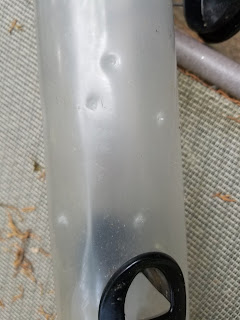 |
| Hermit Thrush |
Looking out on our backyard I could watch robins, cardinals, bluejays, wrens, doves, house finches and sparrows taking turns at the heated birdbath. Barb has created an island of 100 native plant species in a neighborhood sea of sterile mowed yards. While the plants are barren except dried seed heads which the finches feast on, they still provide a degree of shelter while waiting their turn at the feeder
As we tell the WOLF students, "Everything has to survive winter.....or else..." Whether by hibernation, migration or adaptation, every living thing has to survive winter or go extinct. Our migrants have already left for their southern vacation and the only bird that hibernates is the Common Poorwill which doesn't live in Missouri. That leaves the hearty adapters that we see around our feeders.
Although several sources say the Poorwill hibernates, it actually goes into torpor. Three things differentiate hibernation from torpor. Hibernation is voluntary, is driven by shorter daylight hours, and waking up can take hours and use a lot of energy. Torpor is involuntary, and results from falling temperatures (regardless of daylight hours), and the animal wakes rapidly by shivering, which expends energy, but conserves a lot more than hibernators use.
There are things that we advanced bipeds can do to increase their odds, improving their quality of life and benefiting from watching them in winter. You can keep water sources open, provide higher energy feeds (suet, black oil sunflower, shelled peanuts, etc.), and maybe leave a little extra on the ground for squirrels if using squirrel “proof” feeders.
 |
| Photo - Steve Martin |
 |
| Teeth marks- click to enlarge |
Down on Bull Creek it is time to hang up the feeders again. A bear on our deck reminded us this year that we hung up our feeders a little too early. It tore down a feeder hanging on a wire five feet above the deck, leaving its tooth prints as dents in the hard plastic. Now that Bruno is hibernating, or at least doing the intermittent Missouri version, it is time to hang them out again. On our deck above the creek a lot of other critters don't understand the "bird" part of bird feeder. We have a special squirrel feeder with a spring bar that closes the feeder when any weight is on it. The squirrels have learned to put a paw in first to keep it open while they gorge. For a while we had a battery operated feeder that was supposed to give a little shock to a squirrel. I took it down before these smart little rodents could run a wire out to an nearby drey for lighting.
On our deck above the creek a lot of other critters don't understand the "bird" part of bird feeder. We have a special squirrel feeder with a spring bar that closes the feeder when any weight is on it. The squirrels have learned to put a paw in first to keep it open while they gorge. For a while we had a battery operated feeder that was supposed to give a little shock to a squirrel. I took it down before these smart little rodents could run a wire out to an nearby drey for lighting.
My favorite visitor was this opossum. I was able to walk out on the deck and get within two feet of it for closeup photos before it turned around and got back to business licking the suet feeder.
Bill Bryson says: "Life just wants to be." Lets help it all the way up and down the food chain.





.jpeg)